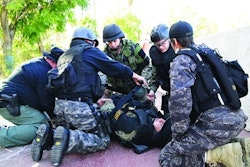It's an altogether too familiar scene. A lectern and a desk stand officiously at the front of a thirty-by-thirty room, facing a half dozen rows of tables and chairs spaced evenly in parallel lines. Matching notepads and pens are set smartly in place. There is a dull murmur among the men and women seated there—each patiently and obiediently awaiting their fate.
Mandatory training. Eight hours. No escape.
An instructor strides to the front of the room, introduces themselves, and launches into a two-minute "about me" speech meant to give those present some sense of why this one person is standing at the front of the room and not sitting among the trainees.
It's pretty plainly apparent that just about everyone—possibly even including the abovementioned instructor—has some level of dread.
They were "checked out" when they checked in.
Mandatory training. Eight hours. No escape.
Engaging the Brain
This is—to say the least—a sub-optimal learning environment. To be slightly more scientific, in this scenario you have a roomful of people who are ether essentially or entirely disengaged from their prefrontal cortex (PFC)—the part of the brain responsible for cognitive functions.
Kerry Mensior—a retired law enforcement veteran with three decades on the job and now executive director of the International De-Escalation Association (IDEA)—says, "Your brain can only be in one of two states. It can be in 'executive state' or it can be in 'survival state.' When you're in 'executive state,' [you're using] your prefrontal cortex (PFC)—that's the thinking, logical, reasoning part of your brain. When you're in 'survival state,' that part of your brain is turned off."
When the PFC is engaged, a student in a classroom can connect with the other students. They can interact with and learn from the other people in the class as well as the trainer. The brain in the executive state can take in the information that's being presented and is able to effectively store that information for recall later. When a person is in 'survival state,' they can't do any of those things.
Mensior says that some researchers contend that humans spend between 70% and 80% of their life in the survival state of brain activity. He says that understanding and accounting for this is essential for trainers to successfully train their students.
"If you have students that are hostages in your classroom—it's mandated training, and they really don't want to be there—you immediately know that their brain is in survival state," he says.
This, then, has the potential to take a trainer who is in executive state—maybe even full enthusiasm for the materials to be discussed—and shift them into survival state, ready for the conflict of cajoling a group of unwilling participants into the learning fray.
"To be an effective trainer is to be able to shift [the students'] brains to executive state," he says. "The very first step in order to be able to do that, is you need to make sure you are in executive state yourself."
This seems self-evident—don't ask a trainee to do something you're unwilling or unable to do—but virtually every trainer is guilty of walking into a training session with the thought lurking in the back of their head, "This is going to suck."
Don't do that.
Dos and Don'ts
Mensior has several thoughts on things to do—and not do—in order to ensure that everyone in the training environment is actively in the executive state of brain function, and poised to get the most from the experience.
Do: Music
Mensior says that he often has music playing as attendees arrive.
"Music affects us on a very subconscious level," he says. "When students walk in the classroom, I've got music playing. It's happy music. It's feel good music."
Don't: Bio
A massive majority of law enforcement training sessions begin with the instructor saying, "I'm Sergeant So-and-So from the Such-and-Such Police Department. I've been a police officer for Oh-So-Many years. I've worked every patrol division in the city, usually through disciplinary transfers."
Under the polite chuckling at the predictable joke, everyone in the room is now mentally counting the minutes until class is dismissed.
Do: Story
Instead of rattling off a recitation of the resume, Mensior suggests that every instructor have in their head a small handful of stories apropos to not only the topic at hand, but the specific audience in attendance. Someone teaching de-escalation techniques in the campus environment will probably want to have one story to engage a group of SROs and another story to engage an assembly of school administrators.
"We've communicated with story for centuries," Mensior says. "When you begin with a story…you immediately catch their attention—you've hooked them."
Don't: Boast
In the same vein as not giving a bio—and certainly related to the art of storytelling—the instructor mustn't make the instruction about the instructor. Mensior says that establishing your bona fides should come in the content you present, not in some litany of accomplishments or accolades.
Mensior says, "You have to get out of the mindset that you have to be the sage on the stage."
The student needs to know that the instructor is there for them, not the other way around.
"It's the Maya Angelou quote," he says. "They don't care how much you know until they know how much you care."
Do: Activate
In order to get people further engaged in the executive state, it's useful to take the larger group and break it into smaller groups for the purpose of an activity. Create groups comprised of a handful of members—enough people to generate some energy in discussion, but a small enough group to foster collaboration. Tell each group to gather in a different location and come up with a name, and an organizational structure including positions such as scribe and speaker.
Mensior says, "Now you've changed their physical state. When you change the physical state, you change the mental state."
Recognizing (and Eliminating) Roadblocks
It's widely accepted among people in the police training community that there are different kinds of learners— auditory, visual, kinesthetic, and reading/writing—and that on the whole there is no significant difference in the academic achievement levels of people with different learning styles. They take different paths to the same destination.
However, it should be equally recognized that there are two essential modes of the brain, and only one of them enables meaningful and lasting learning. In the executive state a person can absorb, analyze, interpret, and remember complex concepts for use at a later time. They have an open highway upon which to get where they want to go intellectually. Individuals in the 'survival state' have potentially deadly roadblocks in their way.
By recognizing the difference between someone in their executive state and survival state of brain activity, trainers can better engage their students in the classroom, and better ensure their success on the street.
















